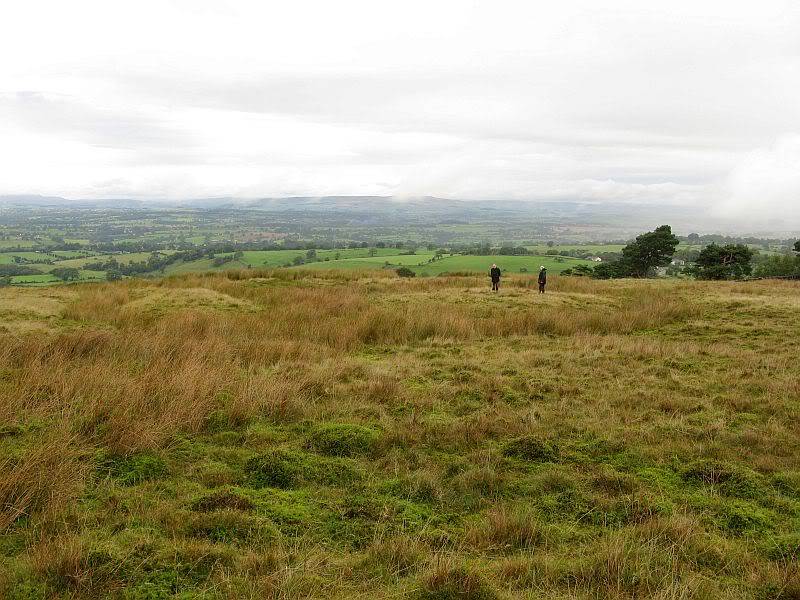 lowergate Wed Aug 31, 2011 3:04 am
lowergate Wed Aug 31, 2011 3:04 am
TWO NEW FINDS ON PENDLE HILL, LANCASHIRE
PENDLE HILL, (1) HORSE-SHOE BANKED ENCLOSURE & (2) DITCHED BOWL BARROW/HENGE
PENDLE HILL, STONEY BANK HORSE-SHOE ENCLOSURE (1), SD 806 428 (site re-evaluation 30/08/11)
The site is located on a raised section of rough moorland named Stoney Bank directly to the north of the Big End of Pendle Hill. The site affords fine views over the upper Ribble Valley with the mountains of the western Yorkshire Dales as a backdrop.
Stoney Bank is a shelf of land on the lower section of failed 18/19th century land enclose on the northern slopes of Pendle Hill and is above the line of 17th to 19th farming settlement. Even today the upper sections of the enclosures are nothing more than rough and boggy pasture fit only for rough grazing for sheep. The ‘shelf’ and the short sections down to the road are the only bits of ‘good’ pasture, so good that the ‘farmers’ here use the land as a general rubbish dump for items that would cost them money to dispose of in a legal and environmentally safe manner – so much for ‘countryside stewardship’ and the Establishment lackey bums who are employed as ‘Countryside Rangers’ at great public expense – enough! Enough of this seditious talk John, get back to the point!
The form is of a circular, horse-shoe shaped raised stone bank some 7ft in width open at one end and facing directly to the east towards the Heights of Wheathead and the Pike of Alainsete.
The raised-banked horse-shoe ringwork has an external diameter of 72ft, and an internal diameter of 58ft. Given the nature of the site and soil build-up the site is not contemporary with the 18th/19th century enclosures having been erected for some as yet unknown reason and purpose in a former Age.
PENDLE HILL, STONEY BANK DITCHED BOWL BARROW/HENGE (2), SD 805 429 (site evaluation 30/08/11)
After Danny, Phillip and I had viewed, measured and re-evaluated the above site we wandered off to field walk the Stoney Bank shelf along with the surrounding moorland enclosed lands as other sites looked probable from Google Earth, etc. – a muddy, boggy enterprise as storm clouds gathered that was eased only by a bottle of fine Californian red wine kindly provided by Danny and fine Dutch tabak.
From a height below the Pendle escarpment at the high limit of the enclosures we noticed a raised mound in an enclosure adjacent (west) to the one the horse-shoe ringwork is sited.
At a point SD 805 429 (Danny will put up the exact GPS with site photos) we located a well defined 60ft. diameter ditched bowl barrow/henge.
Just below this site is an ancient well, now piped, that feeds the 17th cenury farm of Heklin, the farmstead is sited on the highest level of settlement on this side of Pendle Hill in the parish of Downham.
Deposits of ironstone and coal bearing shales were also noted on the Stoney Bank shelf.
Both sites are now recorded on the Lancashire Sites & Monuments Record at Preston.
A good day all round.
cont ... (01/09/11)
The road below the above two sites is historically known as the ‘Lincolngate’, an ancient trans-Pennine route that ran between Clitheroe and Lincoln via Ponefract.
The road starts below the Castle at Clitheroe, runs along Lowergate and Brookgate (now Duck Street) then follows Mearley Brook to Worston via Upbrooks. From there it runs above Downham and over Annel Cross Moor to Laneshaw Bridge beyond Colne. A moorland highway then leads to the former de Lacey estate at Stanbury near Haworth and thus on across the Pennines. This route is recorded in the early charters of Gilbert de Lacy who was granted the Hundred of Blackburnshire after the Norman Conquest.
Befor the Conquest the Anglo-Scaninavian Thegn Leysingr, son of the Thegn Gamall, held tenure of land in the honours of Clitheroe and Pontifract. It is more than likely that this highway existed then.
To state correctly as to the age and origins of this trackway is not an easy task. All sources agree on its ‘ancient’ nature and that during the Medieval period it formed a section of a trans-Pennine highway.
Evidence of early human activity and extensive trade contact in the Stoney Bank vicinity of the trackway are to be found in a number of polished stone axes of Cumbrian and Welsh origin being found hereabouts. Two of these axes were actually found upon the trackway itself. These were products of the Langdale axe factories formed from the Borrowdale volcanic rock Rhyolite (relatively light in weight with a flinty appearance). These axes were important trade items and would not have been discarded lightly.




 Danny
Danny







 or is it the wine ?
or is it the wine ?
























